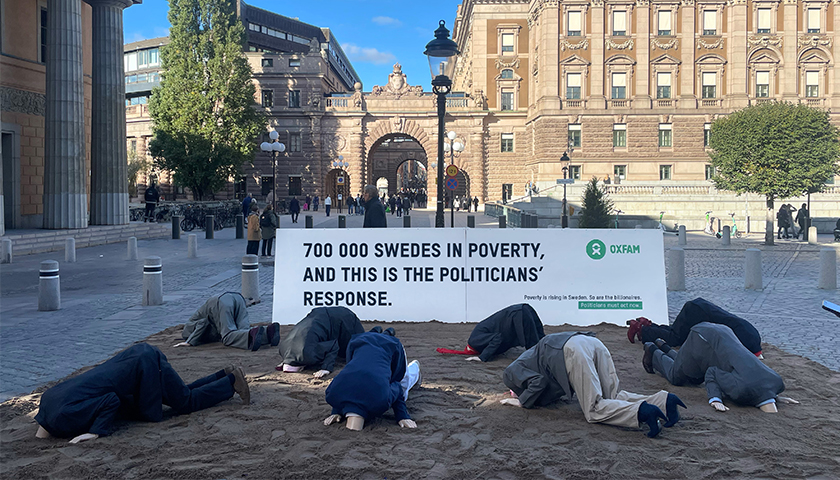The carbon footprints of the richest 1 percent of people on Earth is set to be 30 times greater than the level compatible with the 1.5°C goal of the Paris Agreement in 2030, according to new research out today. It comes after delegates grapple with how to keep this goal alive at the COP26 meeting in Glasgow.
In 2015, governments agreed to the goal of limiting global heating to 1.5°C above pre-industrial levels, but current pledges to reduce emissions fall far short of what is needed. To stay within this guardrail, every person on Earth would need to emit an average of just 2.3 tons of CO2 per year by 2030 – this is roughly half the average footprint of every person on Earth today.
“The emissions from a single billionaire space flight would exceed the lifetime emissions of someone in the poorest billion people on Earth,” said Nafkote Dabi, Climate Policy Lead at Oxfam. “A tiny elite appear to have a free pass to pollute. Their over-sized emissions are fueling extreme weather around the world and jeopardizing the international goal of limiting global heating. The emissions of the wealthiest 10 percent alone could send us beyond the agreed limit in the next nine years. This would have catastrophic results for some of the most vulnerable people on Earth who are already facing deadly storms, hunger and destitution.”
This study, commissioned by Oxfam based on research carried out by the Institute for European Environmental Policy (IEEP) and the Stockholm Environment Institute (SEI), estimates how governments’ pledges will affect the carbon footprints of richer and poorer people around the world. It treats the global population and income groups as if they were a single country. It finds that by 2030:
- The poorest half of the global population will still emit far below the 1.5°C-aligned level in 2030.
- The richest 1 percent and 10 percent of people are set to exceed this level by 30 times and 9 times respectively.
- Someone in the richest 1 percent would need to reduce their emissions by around 97 percent compared with today to reach this level.
But in a sign that the 2015 Paris Agreement is having some impact, the middle 40 percent are on course for per capita emissions cuts of 9 percent from 2015 to 2030. This is a turnaround for a group, which is mostly made up of citizens in middle-income countries like China and South Africa that saw the fastest per capita emissions growth rates from 1990 to 2015.
Looking at total global emissions, instead of per capita emissions, the richest 1 percent – fewer people than the population of Germany – are expected to account for 16 percent of total global emissions by 2030, up from 13 percent in 1990 and 15 percent in 2015. The total emissions of the richest 10 percent alone are set to exceed the 1.5°C – aligned level in 2030, regardless of what the other 90 percent do.
The geography of global carbon inequality is set to change too, with a larger share of the emissions of the world’s richest 1 percent and 10 percent linked to citizens in middle income countries. By 2030, Chinese citizens will be responsible for almost a quarter (23 percent) of the emissions of the richest 1 percent, US citizens for a fifth (19 percent) and Indian citizens for a tenth (11 percent).
“The global emissions gap to keep the 1.5°C Paris goal alive is not the result of the consumption of most of the world’s people: it reflects instead the excessive emissions of just the richest citizens on the planet,” said Tim Gore, author of the briefing and Head of the Low Carbon and Circular Economy program at IEEP. “To close the emissions gap by 2030, it is necessary for governments to target measures at their richest, highest emitters – the climate and inequality crises should be tackled together. That includes both measures to constrain luxury carbon consumption like mega yachts, private jets and space travel, and to curb climate-intensive investments like stock-holdings in fossil fuel industries.”
“Our research highlights the challenge of ensuring a more equitable distribution of the remaining and rapidly diminishing global carbon budget,” said Emily Ghosh, Scientist at Stockholm Environment Institute. “If we continue on the same trajectory as today, the stark inequalities in income and emissions across the global population will remain, challenging the equity principle at the very heart of the Paris Agreement. Analysis of carbon inequality must urgently be put at the center of governments efforts to reduce emissions.”
Oxfam said world leaders should focus on targeting deeper emissions cuts by 2030, in line with their fair share, and ensure that the richest people worldwide and within countries make the most radical cuts. The richest citizens have the potential to speed up this process dramatically, both by leading greener lifestyles but also by directing their political influence and investments towards a low-carbon economy.


